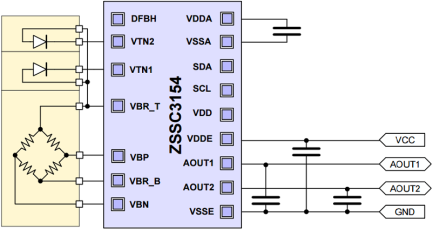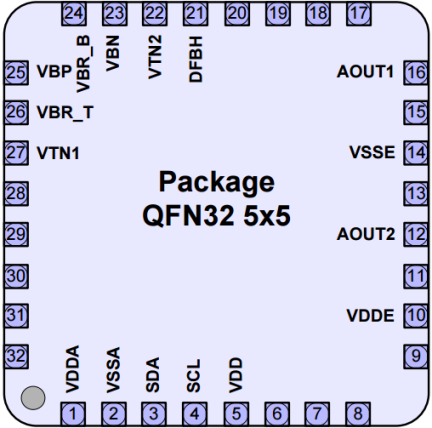Overview
Description
The ZSSC3154 is an integrated circuit for highly accurate amplification and sensor-specific correction of a bridge sensor signal. Up to two temperature sensors can also be read in parallel. The circuitry provides different configurations of the analog outputs to show two measurement results simultaneously. This also allows generating a complementary bridge sensor signal, which is often required in safety-relevant applications. The ZSSC3154 can take readings from two external temperature sensors to compensate the temperature drift of the bridge sensor signal and to output a separate temperature signal. An internal calibration microcontroller in addition with an on-chip EEPROM performs the digital compensation of the sensor offset, the sensitivity, the temperature drift, and the nonlinearity. The one-pass digital end-of-line calibration plus the integrated broken chip-detection supports automatic and highly efficient mass production.
Features
- Differential bridge sensor input
- Half-bridge sensor or temperature sensor input
- Digital compensation of offset, gain, nonlinearity and temperature dependency
- Two analog outputs, behavior programmable by EEPROM configuration
- Sequential analog output mode provides two measurands at one output pin
- Various on-chip diagnostic and safety features including sensor connection diagnostic and broken-chip detection
- 2 EEPROM words for arbitrary user data
Comparison
Applications
Design & Development
Software & Tools
Boards & Kits
Evaluation Kit for ZSSC3154
The ZSSC3154KIT Evaluation Kit provides the hardware needed for configuration, calibration and evaluation of the ZSSC3154 Sensor Signal Conditioner (SSC) IC. The user's PC can communicate with the ZSSC3154 IC socketed on the ZSSC3154 SSC Evaluation Board via the SSC Communication Board through a...
Mass Calibration System for ZSSC3154
The ZSSC3154 Mass Calibration System provides the hardware needed for simultaneous configuration, calibration and evaluation of multiple ZSSC3154 Sensor Signal Conditioner (SSC) ICs. The user's PC can communicate via the SSC Communication Board with multiple ZSSC3154 ICs (DUTs) mounted on either...
ZSSC3154 Mass Air Flow (MAF) Sensor Board
The ZSSC3154 Sensor Signal Conditioner (SSC) is optimized for resistive bridge sensor measurements commonly used in air flow sensing applications. To expedite the design of these applications, IDT provides the ZSSC3154 Mass Air Flow (MAF) Sensor Board for optional use with the ZSSC3154...
Models
ECAD Models
Schematic symbols, PCB footprints, and 3D CAD models from SamacSys can be found by clicking on the CAD Model links in the Product Options table. If a symbol or model isn't available, it can be requested directly from SamacSys.

Product Options
Applied Filters:
Videos & Training
A brief demo and introduction to the ZSSC3154, an integrated circuit for highly accurate amplification and sensor-specific correction of a bridge sensor signal. Up to two temperature sensors can also be read in parallel. The circuitry provides different configurations of the analog outputs to show two measurement results simultaneously. This also allows generating a complementary bridge sensor signal, which is often required in safety-relevant applications. The ZSSC3154 can take readings from two external temperature sensors to compensate for the temperature drift of the bridge sensor signal and to output a separate temperature signal.
Related Resources
Treanscript
Hi, my name's David Grice. I'm an Applications Engineer at IDT. We're here at Sensors Expo, and I wanted to give a brief demo and introduction to the ZSSC3154. It's developed for automotive applications, and we're highlighting an application using mass airflow today.
Okay, this is a special demonstration board using a constant temperature anemometer to measure airflow, and this graphic sort of shows the basic principle. You have a heater in the middle of the flow, the sensors on either side, and to maintain the temperature, you can monitor the mass airflow quantity and the direction. This is a basic block diagram. It interfaces with the two sensor bridges, it also has the two temperature diode measurements, and then we amplify that signal, digitize it, and do the digital correction in temperature compensation. This is the board that we've developed with a CTA sensor. It's a special board just for this demo. This middle board is part of our standard evaluation kit. It has the 3154 on it. And this last board is just a communication board to talk between the GUI and the I2C on the 3154.
Then, on the screen, you can see one of our basic GUIs. Most of our software interfaces look this way. It really helps customers to become familiar with the part quickly and to learn how to configure it. And once you have it configured the way that you need it, do all your calibration, you can store the values into the EEPROM and then it's completely configured permanently.
And here we have it running. I've calibrated it for the two different directions of flow. It's just a small aquarium pump. When I first turn it on, the flows are equal in the tubes, so we're at about 50%, but if I just pinch one of these tubes, you can see the flow changes direction and volume. And I have it calibrated to go from 0% to 100% with these two tubes pinched. And the other thing you can see is it will change an LED on the board, indicating the direction, so as I close off this tube and release it, the two different LEDs light up.
So this is the basic operation and a good overview of what our software interfaces look like.
My name is David Grice. Thanks for watching. If you have any questions or need further information, look on our website at idt.com. Thank you.







